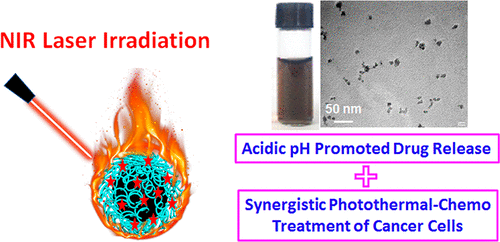当前位置:
X-MOL 学术
›
ACS Biomater. Sci. Eng.
›
论文详情
Our official English website, www.x-mol.net, welcomes your
feedback! (Note: you will need to create a separate account there.)
Polyacrylic Acid Functionalized Co0.85Se Nanoparticles: An Ultrasmall pH-Responsive Nanocarrier for Synergistic Photothermal-Chemo Treatment of Cancer
ACS Biomaterials Science & Engineering ( IF 5.4 ) Pub Date : 2018-01-10 00:00:00 , DOI: 10.1021/acsbiomaterials.7b00878 Yan Ma 1 , Xianwen Wang 1 , Huajian Chen 1 , Zhaohua Miao 1 , Gang He 1 , Junhong Zhou 1 , Zhengbao Zha 1
ACS Biomaterials Science & Engineering ( IF 5.4 ) Pub Date : 2018-01-10 00:00:00 , DOI: 10.1021/acsbiomaterials.7b00878 Yan Ma 1 , Xianwen Wang 1 , Huajian Chen 1 , Zhaohua Miao 1 , Gang He 1 , Junhong Zhou 1 , Zhengbao Zha 1
Affiliation

|
To surmount the challenges of limited drug penetration and therapeutic resistance in solid tumors, stimuli-responsive nanocarrier-based drug delivery systems (DDSs) with relatively small sizes are inherently favorable for combined treatment of cancerous cells. In this work, poly(acrylic acid) (PAA) functionalized Co0.85Se nanoparticles (PAA-Co0.85Se NPs) were synthesized through an ambient aqueous precipitating approach for synergistic photothermal-chemo treatment of cancer. The obtained PAA-Co0.85Se NPs possess ultrasmall size (8.2 ± 2.6 nm), considerable near-infrared (NIR) light absorption, high photothermal transforming efficiency (45.2%) and low cytotoxicity, all of which are beneficial for localized photothermal ablation of cancer cells. Doxorubicin hydrochloride (DOX·HCl) was then successfully loaded on PAA-Co0.85Se NPs with a loading capacity up to 8.3% to form PAA-Co0.85Se-DOX composites, which exhibited an exciting acidic pH-responsive drug release property due to the protonation of amino groups in DOX and carboxyl groups in PAA molecules. As expected, when HeLa cells were treated with PAA-Co0.85Se-DOX NPs as well as NIR laser irradiation, a significant synergistic cell-killing effect was observed, greatly improving the treatment efficiency. Thus, this work presents novel insight into the design of ultrasmall stimuli-responsive nanocarrier-based DDSs for synergistic photothermal-chemo treatment of cancer cells.
中文翻译:

聚丙烯酸功能化的Co 0.85 Se纳米颗粒:超小pH响应纳米载体,用于协同光热化学治疗癌症。
为了克服实体瘤中有限的药物渗透和治疗抗性的挑战,具有相对较小尺寸的基于刺激响应性纳米载体的药物递送系统(DDS)本质上有利于癌细胞的联合治疗。在这项工作中,通过环境水沉淀法,以协同光热化学疗法治疗癌症,合成了聚丙烯酸(PAA)功能化的Co 0.85 Se纳米颗粒(PAA-Co 0.85 Se NPs)。获得的PAA-Co 0.85硒纳米颗粒具有超小尺寸(8.2±2.6 nm),相当大的近红外(NIR)光吸收,高的光热转化效率(45.2%)和低的细胞毒性,所有这些均有利于癌细胞的局部光热消融。然后,将阿霉素盐酸盐(DOX·HCl)成功地负载在PAA-Co 0.85 Se NPs上,负载量高达8.3%,形成PAA-Co 0.85 Se-DOX复合材料,该复合材料具有令人兴奋的酸性pH响应药物释放特性,这是由于DOX分子中的氨基和PAA分子中的羧基的质子化 不出所料,当用PAA-Co 0.85处理HeLa细胞时Se-DOX NPs以及NIR激光辐照,观察到了显着的协同细胞杀伤作用,大大提高了治疗效率。因此,这项工作为协同作用光热化学疗法治疗癌细胞的超小型刺激响应性基于纳米载体的DDS的设计提出了新的见解。
更新日期:2018-01-10
中文翻译:

聚丙烯酸功能化的Co 0.85 Se纳米颗粒:超小pH响应纳米载体,用于协同光热化学治疗癌症。
为了克服实体瘤中有限的药物渗透和治疗抗性的挑战,具有相对较小尺寸的基于刺激响应性纳米载体的药物递送系统(DDS)本质上有利于癌细胞的联合治疗。在这项工作中,通过环境水沉淀法,以协同光热化学疗法治疗癌症,合成了聚丙烯酸(PAA)功能化的Co 0.85 Se纳米颗粒(PAA-Co 0.85 Se NPs)。获得的PAA-Co 0.85硒纳米颗粒具有超小尺寸(8.2±2.6 nm),相当大的近红外(NIR)光吸收,高的光热转化效率(45.2%)和低的细胞毒性,所有这些均有利于癌细胞的局部光热消融。然后,将阿霉素盐酸盐(DOX·HCl)成功地负载在PAA-Co 0.85 Se NPs上,负载量高达8.3%,形成PAA-Co 0.85 Se-DOX复合材料,该复合材料具有令人兴奋的酸性pH响应药物释放特性,这是由于DOX分子中的氨基和PAA分子中的羧基的质子化 不出所料,当用PAA-Co 0.85处理HeLa细胞时Se-DOX NPs以及NIR激光辐照,观察到了显着的协同细胞杀伤作用,大大提高了治疗效率。因此,这项工作为协同作用光热化学疗法治疗癌细胞的超小型刺激响应性基于纳米载体的DDS的设计提出了新的见解。











































 京公网安备 11010802027423号
京公网安备 11010802027423号